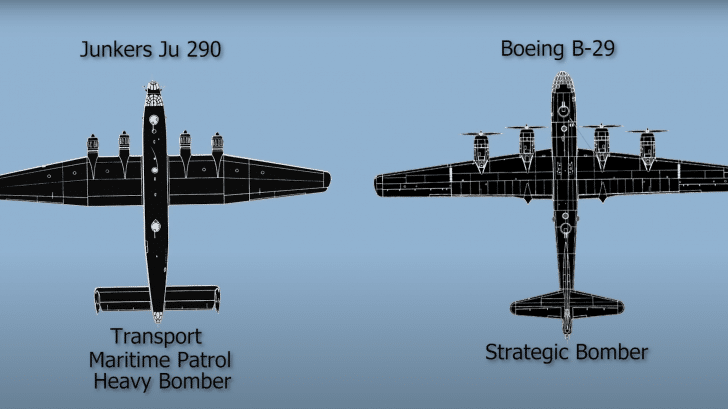In this video, we’re going to take a look at three Junkers designs, the Ju90, 290, and 390, and why they failed.
Design Origins
The story of the Junkers giant goes back to the Ju, which itself is an enlarged version of the Ju89 bomber.
This was a mid-1939 contender for the so-called ‘Ural Bomber’ specification, issued by the RLM. This outlined an aircraft capable of striking targets as far as the Ural Mountains in Soviet Russia from German territory.
However, the ‘Ural Bomber’ specification was canceled in 1937. One of the reasons where the doubts about Germany’s industrial capacity to build large bombers en mass essentially killed the Ju 89.
The J290
The Ju 290 was the biggest landplane that was to achieve series production in Germany during the war.
It had a length of 28.6 meters (94 ft) and a wingspan of 42 meters (137 ft 10 inches.) This plane was only a little bit smaller than the Boeing B-29 Superfortress.
The Experimental Ju 390
The 390 was a rather fascinating and distinct development of the 290, which mostly involved bolting on two additional engines and enlarging the aircraft to try and increase its huge range even further.
The 390 program is fairly shrouded in mystery and not much is known about it. The first prototype, the V1, was constructed in Dessau and underwent its maiden flight in October 1943. Meanwhile, the second prototype was built in mid-1944 though it never flew.
Japanese Interest
The Japanese showed a large interest in the 390 program, considering it of ‘utmost importance.’ However, during the mid-1944 they have other things to worry about, but their interest remained.
At this point, Junkers prepared all of the manufacturing and instructional documents ready to hand over to Japan, but negotiations ended in January 1945, and nothing more came of it.
Service History
The Ju 90 and 290 in all its variants and version, would overall leave a fairly modest footprint in World War II- with only 18 and 65 being built respectively.
Nonetheless, the aircraft represented a capable, fast, modern, and well-defended transport in the early years. For instance, in 1940, it would see its first operations with the Luftwaffe, being used as a transport aircraft during the Norwegian campaign. It was tasked to carry a large number of supplies, ammo, and weaponry from Germany.
Although operational usage had stayed modest for the next couple of years. It undertook general transport duties, and the use of the aircraft would seriously ramp up in late 1942 as plans were in place to put up a four-engine transport squadron that would supply troops in Soviet territory.
For a time, these planes were large ambitious planes, particularly for a country whose industry preferred medium-sized designs. They were also well-equipped despite their small numbers, such as supporting ground troops in Norway, carrying supplies to Fareast Asia, and serving as convoys in the Atlantic. However, this was also their biggest downfall, these planes were scattered in various roles that it wasn’t designed for and any losses were almost impossible to replace.


